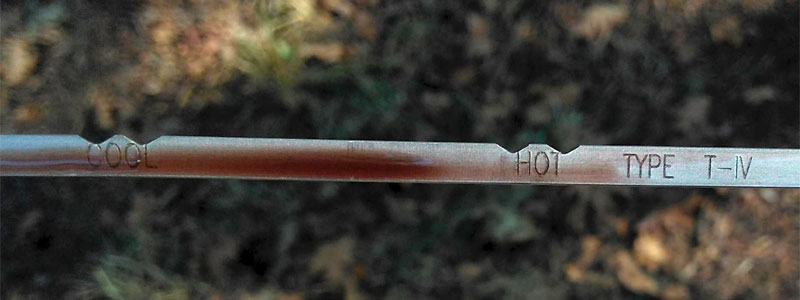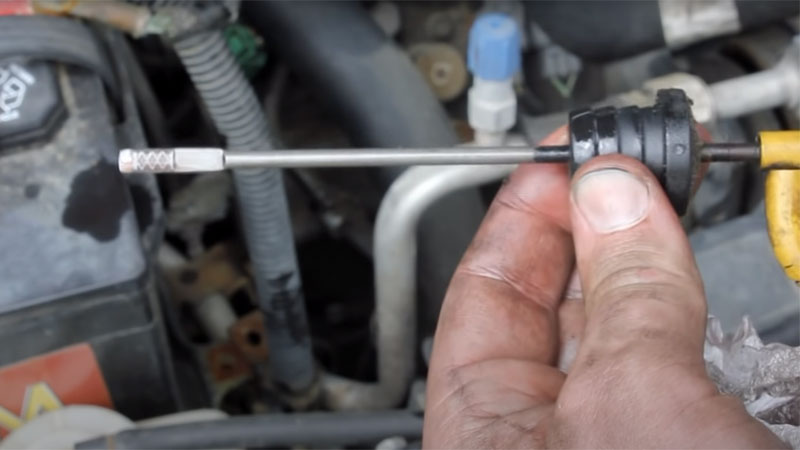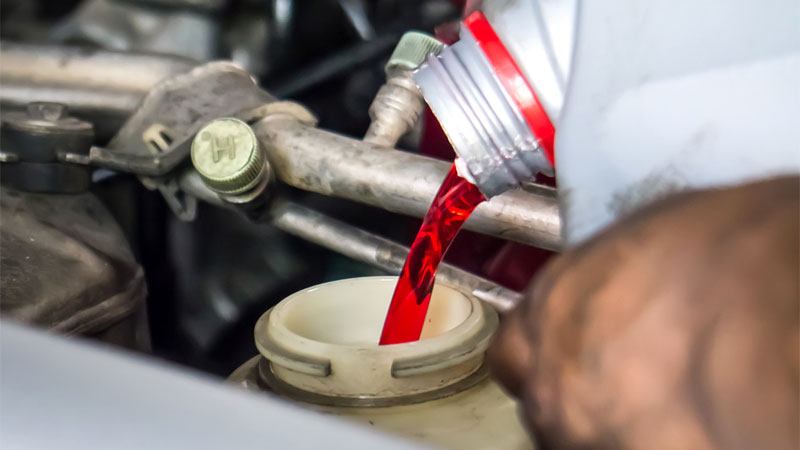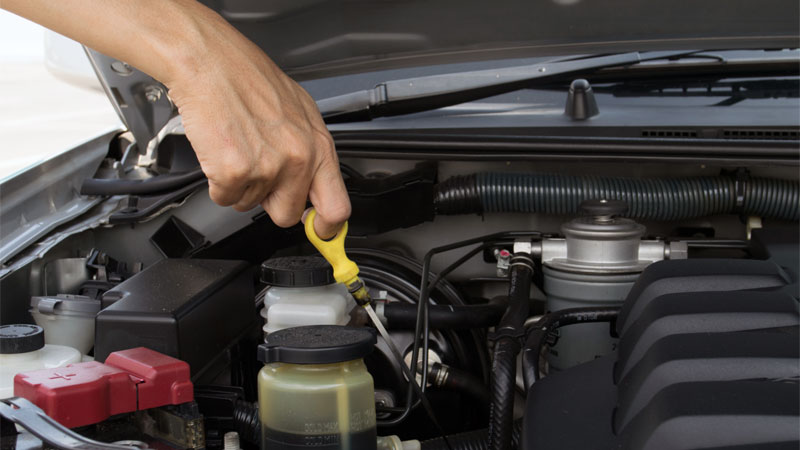Checking your transmission fluid is vital for preventing serious, costly damage down the road. But does it matter whether you check hot or cold?
Getting it right matters, as incorrect fluid levels can spell transmission trouble. Read on to learn the ideal time and technique for inspecting your transmission fluid.
Read Also: How Often Should You Change Transmission Fluid?
When to Check Transmission Fluid
Checking When Hot or Cold?
Generally, you’ll want to only check transmission fluid when the engine is fully warmed up and idling.
When the vehicle is first started and the engine is cold, the transmission fluid is condensed and hasn’t started circulating fully throughout the system yet. Once warmed up to operating temperature and idling, the fluid is flowing through all components that require lubrication and is expanded to a normal state the dipstick can accurately measure.
Turning off the engine allows fluid to drain back down into the pan, giving you an incomplete look at actual operating levels.
Why Is There a Hot and Cold Mark on the Dipstick?

The “cold” mark on the transmission dipstick primarily serves as a factory fill line to ensure there is adequate fluid from the outset to prevent damage at first startup. It does not necessarily indicate a recommended minimum fluid level for continued operation after leaving the production line.
Rather, the dipstick’s “hot” mark reflects the target operating level that the transmission has been designed for. So while the cold mark provides the factory a safety net for newly-built transmissions, the hot mark is the one to pay attention to when checking your fluid.
Follow Vehicle Manufacturer’s Guidelines
With so many different vehicle and transmission combinations out there, be sure to follow your vehicle manufacturer’s guidance exactly. Testing procedures can differ slightly between makes and models. Some specify needing to have the vehicle running and idling in park, while others want it in neutral or maybe after a few minutes of spirited driving.
Consult your owner’s manual for the proper setting of gear selection, engine status, temperature prerequisites, and any other special conditions to verify before pulling out that dipstick. Precise steps lead to precise readings.
Properly Checking Transmission Fluid Level

Follow these steps to get the most accurate results when checking fluid levels in your transmission:
1) Warm Up the Vehicle
Run your vehicle until the engine reaches operating temperature and the transmission is warm. Cold fluid will provide unreliable readings on the dipstick. Operating temperature ensures the fluid has expanded to the proper level for measurement.
It’s a good idea to shift through all gears (1st gear through reverse) a couple of times. This allows fluid to flow into all internal valves and passageways, filling the entire system. Taking the transmission through all gears guarantees everything has reached maximum capacity first.
Some car manufacturers may even specify that you should drive your vehicle like normal for a few minutes so check that owner’s manual.
2) Shift to Park
While parked on a flat surface and with the engine idling, shift your automatic transmission into the Park setting and apply the parking brake. Keep your engine idling at all times during the process.
3) Locate Dipstick
The transmission dipstick handle location can vary between vehicle makes and models. Some are near the engine oil dipstick, but others may be elsewhere under the hood. Consult your owner’s manual or search online to find the transmission dipstick equipped in your vehicle.
4) Remove Dipstick
Similar to checking your engine oil, pull out the transmission dipstick fully and wipe any fluid residue from the end using a clean rag. This prepares the marked end to obtain a precise fluid level reading without any fluid remnants or dirt present.
5) Reinsert and Remove
Push the dipstick fully back into place, then pull it right back out again. This allows you to get a true snapshot of the current operating fluid level, rather than residual fluid remaining on the dipstick from your initial removal.
Related: 10 Symptoms of Low Transmission Fluid
6) Assess Fluid Color and Level
First check that the transmission fluid itself looks healthy – clear, red or pink, without any dark coloration or strong odd odors. Then note where the fluid level lands.
Most transmission fluid dipsticks will have a Hot (or Warm) range, shaded area, notches, or dots signifying the proper fluid level. That is where you want to be. Again, check with your owner’s manual to make sure you are interpreting fluid level marks correctly.
7) Adding Fluid

If your transmission fluid level falls below the correct level, you’ll need to add transmission fluid to bring it up to the proper levels.
See: How to Add Transmission Fluid (Automatic or Manual Transmissions) for a step-by-step process.
FAQs
Where Can I Find the Transmission Dipstick in My Vehicle?
Finding the transmission dipstick in your vehicle is usually a pretty straightforward process, though the exact location can vary slightly depending on the make and model. Here are some tips for locating it:
- Check your owner’s manual. The manual will give clear directions on where to find the transmission dipstick. It may be labeled and near the engine oil dipstick, or tucked away in a different spot.
- Look near the engine. In most vehicles with front-wheel drive, the transmission dipstick handle will be located toward the front of the engine compartment, near the radiator or battery. Rear-wheel drive dipsticks are typically found closer to the firewall.
- Identify by shape or label. Most transmission dipsticks have a ring or loop on top of the handle, while the engine oil stick is straight. Some have “TRANS” printed directly on the handle. Make sure you pull out the right one.
- Feel the texture. Some (but not all) transmission dipsticks often have grooved metal or plastic handles, as opposed to the smooth engine oil stick. This helps differentiate by touch.
- Follow the transmission lines. If you’re still unsure, trace the metal lines running to and from the transmission. This usually leads right to the dipstick location. The tube will be securely mounted nearby.
What’s the Difference in Transmission Fluid Level When Checked Hot Versus Cold?
Checking the fluid level when the engine is warmed up provides the most accurate reading of how much fluid is actually reaching all the internal components under normal operating conditions.
When the transmission is hot, the fluid expands and circulates more freely, essentially giving you a “full” reading that reflects the amount present after everything has come up to temperature. Cold fluid tends to measure lower, being more dense and contracted, and won’t reveal if there is enough volume present to properly fill the transmission once the whole system reaches operating heat and pressure.
Ultimately, you want to mimic real-world operating state rather than just a static cold measure.
What Should I Do if My Car Doesn’t Have a Transmission Dipstick?
Some newer vehicles no longer have a physical dipstick for owners to check the transmission fluid level at home. Often, they will use a sensor to measure fluid levels and display a warning message if a low fluid state exists. If your car lacks a transmission dipstick, try these instead:
- Check your owner’s manual. A few models without a dipstick may have an alternative way to check transmission fluid, like a plug on the transmission itself. Your manual will advise if and how this can be done.
- Look for a fill tube. Cars without a dipstick often have a fill tube with markings instead. The car must be running and warmed up to properly read this tube.
- Count on an automotive tech. If there’s no owner-accessible checking method, the fluid then requires periodic inspection by a mechanic or service tech. They have the tools to verify levels.
- Inspect based on intervals. Without ability to personally check fluid, rely on age/mileage drain intervals instead. Most transmissions today don’t need changes more often than 60k-100k miles.
- Power Windows Not Working? (10 Common Causes and How to Fix) - February 8, 2024
- 14 Causes of a Car Losing Power When Accelerating - January 23, 2024
- 13 Causes of Poor Gas Mileage (Increase Your MPG) - December 13, 2023


Thank you very much for a very clear and helpful write up.
Aamir Raza
I have a 2002 Buick LeSabre transmission oil recommends Havoline dextron 3 but I cannot find that brand I found Valvoline Dex 3 will that work okay
If it’s the same DEXRON rating it should be fine.
05’ Nissan Altima 2.5s has been parked for 3wks due to leaking rack and pinion and sever leak on both sides the whole front left-right axle the bottom of car is soaked wet thick sludge. I don’t think theres any transmission fluid in it is there a way to check fluid cold? Before starting car so not to burn tranny.
1. Do you fill auto transmission fluid with the car on or off? Then restart car to check levels?
If my fluid is above the hot Mark when it’s cold what does that mean
Automatic transmission fluid should be checked at idle.
when driving my 2000 es300 lexus, my car shifts up to 2/3 then it won’t shift back down to change gears
How is your transmission fluid level?
Hey fluid in transmission is full when its cold but after driving when its hot it shows no fluid at all do I need to add fluid its a light pink color and car has 400,000 miles runs great 2000 Buick regal LS
The owner’s manual should outline a procedure for checking the transmission fluid. Many cars need you to check it in park and at idle after it’s reached operating temperature for a correct reading.
If you can’t find it in the manual, try searching for “2000 Buick Regal LS check transmission fluid”.
Does it need to be sevice if the transmisson start slipping when you stop at a stop sign
Hi Salvadora, if your transmission is slipping it sounds like you may have a problem. It wouldn’t hurt to have it checked out.
You talk about everything possible except if it is reading above the full level(high)mark. Give your knowledge on what could happen if it’s high mark .cold an hot?
Excessive overfilling of the transmission fluid could damage the transmission.
Thanks so much for the knowledge you share keep it up.